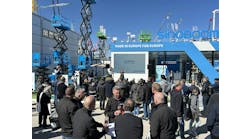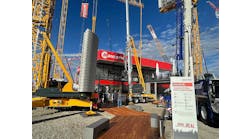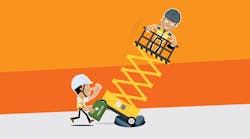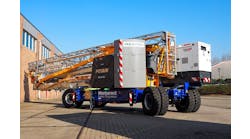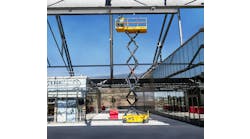RER interviews Matt Fearon – Genie president, Terex AWP about how telematics are changing the way machines are serviced, hybrid solutions, meeting the new ANSI standards and more.
RER: What have been the major new developments to your company’s technology and products in the past year?
Fearon: We brought some great innovations to market within the last year. One of the most exciting things about our business today is the way technology is advancing. We’ve got that happening right now in telematics. We’ve been putting telematics-ready devices on our machines since 2015, and with the introduction of the Genie Lift Connect telematics solution earlier this year (January), our new telematics program is the next phase of our brand’s telematics journey.
We believe the time is right to save our customers money in the form of fewer service calls, more rental time on every machine.
This is a big commitment from us as we’re putting it on all of our booms, scissor lifts and telehandlers with a free three-year subscription. And, we’ve got it tailored: Customers go in, they go to the portal and there are dashboards in there, and they’ve got all the pertinent information that a rental company might want right there. And, they can tailor it even more to fit their specific needs. For example, the larger rental companies can reconfigure it with data.
We’re doing this because it addresses a big industry issue: There are not enough service techs. And, this is a solution for that. If we save one service call per week for a rental company, which I think is extremely conservative, that’s worth a lot. They don’t want to send a truck out for a couple of hours to fix a dead battery, and it’s hard to make money that month on that machine. This is important because telematics is going to change the way the machines are serviced.
We’ve got a solution that works for the big rental companies, as well as the smaller rental companies who maybe don’t have the IT capabilities to outfit their own system. I think customers, big and small, are changing the way they manage their fleets. We have a history of being innovators, and this is an example of that.
From the manufacturers’ standpoint, there are things we can learn about machines. We want to know how to make machines better, we want to know how they’re used, we want to understand do we have too much material on them, because rental companies are constantly telling us “you got to get the cost down, we can’t get the rental return.”
Genie also continues to invest in products and accessories related to the changing requirements of our global customers and how end-users do work safely and productively. The new Genie Xtra Capacity (XC) booms are designed for just that purpose: To provide exceptional capacity consistently across a wide range of products. When customers see the “XC” nomenclature on a Genie machine, they will know that they are getting 660-pound capacity over the maximum range of motion, and 1,000-pound maximum capacity to tackle even the heaviest jobs in less time. The “XC” stamp also signifies that these machines meet the new machine requirements of the updated ANSI and CSA standards in North America, as well as the EN280 standards in Europe and the AS 1418.10 standards in Australia.
I also feel that Genie is leading in the hybrid technology. Our engineers have put a lot of time and effort into making sure that we’re putting the right level of technology in and not losing any performance to get the features that the customers want. Genie FE technology performs as good, or better than, a traditional diesel machine. It runs quiet, it can run with the engine on, it has the 24-horsepower engine which can accept any fuel so when our customers need to dispose of the machine, if they want to dispose of it offshore, there are few limitations. If they have a Tier 4 Final engine, the fuels don’t work everywhere in the world, so the Genie FE hybrid solution is the full package.
Obviously the upcoming ANSI standards are an important topic. What have you done to change your equipment technologically to prepare it to be compliant with the new standards?
All Genie MEWPs globally will now feature load sensors and higher load capacity ratings to comply with those requirements in the new standards. And, to adhere to the wind rating requirements in the new standards, MEWPs will now be categorized as either indoor or outdoor machines. Indoor-only aerials may be lighter weight, but they will be limited to work in areas not impacted by wind. Machines rated for outdoor use will be designed and manufactured for use in wind as limited by the new standards and as specified on Genie machines.
For people who have not been following the ANSI changes, can you sum up how your equipment will change on a practical jobsite level – in other words, what will the customer find different?
Two big things customers will notice in the new standards – changes in Equipment Terminology and changes in Equipment Design Standards. Here’s a quick summary:
Equipment Terminology
Aerial Work Platforms (AWPs) will now become known as Mobile Elevating Work Platforms, or MEWPs. The word “mobile” is important because it means that the equipment can be driven, either under its own power or by manual effort; it is not stationary.
In previous iterations of the standards, AWPs were classified by product types, such as booms, scissors and so on. In the new standards, MEWP classifications are made up of a combination of two key distinguishing descriptions:
a) a MEWP Group
b) an associated MEWP Type
A MEWP Group is determined by the platform location in reference to the equipment’s tipping line, which is either at the wheels or the outriggers.
A Group A machine has a design that does not allow the main platform to extend beyond the tipping line. In other words, the platform does not go outside of the drive chassis envelope. A perfect example of a Group A would be a scissor lift.
Conversely, a Group B machine has a design that allows the platform to extend beyond the tipping line. A great example of a Group B machine would be an articulating or telescopic boom.
A MEWP Type is in reference to the equipment’s ability to travel:
Type 1 – Traveling is allowed only with the MEWP in its stowed position
Type 2 – Traveling with the work platform in the elevated position is controlled from a point on the chassis
Type 3 – Traveling with the work platform in the elevated travel position is
controlled from a point on the work platform
Type 2 MEWPS are not as common as the others. In fact, Genie does not manufacture any machines within this category so for the purposes of this article, I will focus on Type 1 and Type 3 machines only.
An example of a Group A, Type 1 MEWP would be the Genie AWP Super Series manually propelled lifts. The platform never extends beyond the tipping line, and the machine is designed to only be moved with the platform in the stowed position.
The Genie TZ-34 and TZ-50 trailer-mounted booms are examples of a Group B, Type 1 MEWP. The platform is designed to extend beyond the tipping line, and the machine is designed to only be moved with the platform in the stowed position.
An example of a Group A, Type 3 MEWP would be electric or rough terrain scissor lifts. The main platform never extends beyond the tipping line, and machine travel is controlled from the platform controls.
Articulated and telescopic booms are examples of a Group B, Type 3 MEWP. The platform is designed to extend the tipping line, and machine travel is controlled from the platform controls.
Equipment Design Standards
In addition to the terminology and language changes in the new ANSI A92 and CSA B354 standards, the standards also include several big changes to the equipment itself:
- Platform Load Sense (aka Overload System or Load Sense System) — All MEWPs will be required to continuously check the weight in the platform and disable certain functions if the load is above the platform load limit.
- Dynamic Terrain Sensing (aka Chassis Tilt Sense System) — Drive and certain boom functions must be disabled when out of their slope limit and functions restricted only to those that safely return the machine to terrain that is within limits.
- Indoor-only Machines — Allows for the development of smaller, lighter-weight MEWPs bearing an “indoor only” rating because these MEWPs cannot be used in conditions where they might be subjected to any wind.
In addition to the changes highlighted above, there will be many other alterations including:
- Toeguards on work platform entrances
- Prohibited use of chain gates and flexible gates
- Reduced lift and lower speeds on some models.
For rental people, how will their responsibilities change with the new ANSI standards?
One of the more significant equipment changes coming from the updated standards will be the addition of platform load sense. Because Genie Mobile Elevated Work Platforms (MEWPs), formerly known as aerial work platforms, are now manufactured to be in compliance with these standards, rental stores need to understand what’s happening. Here’s a quick summary:
What rental stores need to know
Platform load sense, also known an overload system or load sense system, is being implemented into the current standards to align with existing worldwide standards. This new provision requires existing worldwide standards. This new provision requires many MEWPs to monitor the weight in the platform and disable functions if the load is above the platform load limit. Essentially, it means that the machine will only allow operators to move and place loads that are within the rated capacity of the platform.
Overloading the platform
Since this may be the first time rental employees or customers have had to think about what happens if the platform is overloaded, here’s a quick summary of what to be aware of: There are two ways to overload a platform: 1) Too much weight in the basket before it leaves the ground, and 2) adding weight to the basket once it is in the air working.
Common culprits of overloading the platform are:
- Platform capacity is not just calculated by the number and weight of people in the basket. It also includes tools like welding equipment, hammers and buckets, and materials such as pipes, panels, signage and windows.
- It also includes operators’ clothing and personal gear. For example, heavy jackets and boots needed for work in cold-weather conditions all count toward the platform’s total capacity.
- Not calculating the weight of jobsite tools or materials accurately. For example, it is easy to put a bucket with a few tools in the basket and not realize that bucket weighs 50 pounds or more.
- Touching part of the building or structure you are working near, such as a beam or window ledge, during operation. The weight added from the structure also counts toward the platform’s load capacity.
Everything contributes to the weight in the platform, which means that everything will be counted in the platform load sense calculations as it compares the platform’s capacity to the machine’s load chart.
What can operators do to prevent overloading the platform? The best way is by understanding the weight of the load being placed in the platform before operating.
Field calibrations recommended
To do calibrations in the field, your technicians will need a digital scale and weights. We recommend steel or plastic barrels filled with water. See the product service manuals for your Genie MEWPs to follow the manufacturer’s recommended calibration procedures for each individual unit.
Once the machine is calibrated for the anticipated platform weight, you can load everything up and get the platform in the air — it’s time to get to work.
Remember: Any weight added to the platform that exceeds capacity after the machine is in operation, will flag the MEWP’s load sense sensor and could trigger the overload alarms.
When the platform becomes overloaded
With the new platform load sense requirement, MEWPs will be equipped with a sensor, or load sense cell, which has both an audible and visual alarm to alert the operator that the platform has been loaded above the machine’s load limit capacity.
On Genie MEWPs, when the platform is overloaded a load sense recovery feature, built into the platform load-sense technology will allow operators to return safely to the ground through limited functionality allowed, from either the platform or ground control station. Please note: Drive and steer functions are not allowed during recovery.
As soon as operators are safely on the ground, they must remove weight from the platform until the overload warnings, audio and visual, turn off before returning to work.
It is important to proactively educate rental store employees and customers about what this alarm means, as well as train them on the safe operating procedures necessary to resolve the situation.
Managing mixed fleets
It is important to know that these updated standards requirements only apply to newly built machines, so there is no need for rental stores to make any changes to their existing fleets.
But as rental stores add new equipment to their fleets, they will need to be ready to answer questions with employees and customers will have about platform load sense requirements. Particularly, they need to be prepared to communicate how older versus newer versions of equipment models will operate in the field.
In addition to understand the changes in equipment terminology and design, rental stores will also need to be up to date on the new training requirements in the new standards. For rental stores specifically, here’s quick summary:
Maintenance and Repair Personnel Training
Users must ensure that maintenance and repair personnel are trained by a qualified person to inspect and maintain the MEWP in accordance with the manufacturer's recommendations, as well as ANSI and CSA standards.
In the case where a MEWP is being rented, arrangements must be made by the owner to identify the entity that will be responsible for the inspections and maintenance activities described in the standard:
Frequent Inspections — When the MEWP is put into service or has been out of service for three months.
Annual Inspections — Performed no later than 13 months after the previous Annual Inspection.
What do you suggest rental people do to communicate with their customers about the new ANSI standards?
Genie has developed a lot of content related to the upcoming ANSI changes that rental stores need to know about the new standards. To make it easy for our customers, as well as industry partners, all of the content/materials (videos, white papers, Q&As, checklists, product information, training information, etc.) are available publicly on our ANSI A92 page: https://www.genielift.com/en/support/ansia92-csab354
How will training programs change with the implementation of the new standards?
There are several changes in training requirements in the new standards. Here’s a quick summary:
Safe Use and Planning
The user must develop a Safe Use Program specific to MEWPs which must include, but not be limited to:
- Performing a site risk assessment;
- Selection, provision and use of a suitable MEWP and associated equipment;
- An assessment that the support surface is adequate to support the weight of the MEWP;
- MEWP maintenance including inspections and repairs as required;
- Inform the operator of local site requirements and warn and provide the means to protect against identified hazards;
- Have a trained and qualified supervisor to monitor the performance or the work of the operator;
- Prevention of unauthorized use of the MEWP;
- Safety of persons not involved in the operation of the MEWP.
Risk Assessment and Rescue Planning
The risks associated with the task specific to MEWP operations shall be identified. These might be associated with the location where the work is to be carried out, the nature of the MEWP or the personnel, materials and equipment to be carried.
- Identify control measures;
- Identify safe work procedures;
- Rescue from height;
- Communicate the results.
The user must develop a written rescue plan that will be carried out in the case of machine breakdown, platform entanglement or fall from platform. The plan shall be put in writing and become part of the company's training manual.
All occupants must receive training that explains procedures to follow if they fall and await rescue or witness another worker's fall. This plan must limit the time that a properly restrained worker hangs suspended in the air. Rescue plans can include the following:
a) Self-rescue – by the person involved
b) Assisted rescue – by others in the work area
c) Technical rescue – by emergency services
Training (Operators, Supervisors & Occupants)
To prepare for these standards changes, it is important for users (most commonly the employer) to understand several significant changes.
Supervisor Training (ANSI only)
The user must ensure that all personnel that directly supervise MEWP operators are trained in the following areas:
a) Proper selection of the correct MEWP for the work to be performed;
b) The rules, regulations and standards that apply to MEWPs, including the provisions for safe
use as defined in ANSI A92.22 Training and Familiarization, and the work being performed;
c) Potential hazards associated with use of MEWPs and the means to protect against
identified hazards;
d) Knowledge that the manufacturer's operating manual(s) are an integral part of the equipment and need to be stored properly in the weather resistant compartment on the MEWP.
Occupant Training
The MEWP operator must ensure that all occupants in the platform have a basic level of knowledge to work safely on the MEWP.
a) The requirement to use fall protection and the location of fall protection anchors;
b) Factors including how their actions could affect stability;
c) Safe use of MEWP accessories they are assigned to use;
d) Site specific work procedures the occupants must follow related to the operation of the MEWP;
e) Hazards related to the task at hand and their avoidance;
- Manufacturer’s warnings and instructions;
g) At least one of the occupants must be provided with the knowledge to operate the controls in an emergency where the operator cannot.
What new safety measures have you implemented in the past year?
The adoption rate of secondary guarding and sensing technologies in the aerial work platform industry is picking up pace. Bordering industries with shared applications have technologies that we can expect to see adopted by aerial equipment technologies which will improve productivity, workplace safety and rROIC for equipment rental organizations.
For example, demand for secondary guarding solutions on scissor lifts and vertical lifts often comes as a request for a boom solution to be mounted directly to the lift platform. Applications and platform configurations vary greatly between scissor and boom products, requiring secondary guarding solutions of similar function, but different form. The Genie Lift Guard Contact Alarm for scissor lifts/vertical lifts was designed and named to feel familiar to operators who are currently experienced with the Genie Lift Guard Contact Alarm on boom lifts today.
One of the more significant equipment changes coming in the upcoming changes to ANSI A92 and CSA B354 standards is be the addition of platform load sense (as mentioned above). This new provision requires many mobile elevated work platforms (MEWPs), formerly known as aerial work platforms, to monitor the weight in the platform and disable functions if the load is above the platform load limit. Essentially, it means that the machine will only allow operators to move and place loads that are within the rated capacity of the platform. With the new platform load sense requirement, MEWPs will be equipped with a sensor, or load sense cell, which has both an audible and visual alarm to alert the operator that the platform has been loaded above the machine’s load limit capacity.
On Genie MEWPs, when the platform is overloaded a load sense recovery feature, built into the platform load sense technology, will allow operators to return safely to the ground through limited functionality allowed, from either the platform or ground control station. And, the Genie MEWPs equipped with a load sense are designed with a load sense cell that continuously checks the weight in the platform and limits the operating envelope to match the load chart, all while boasting the ability to do zero load field calibrations.
Are you seeing an increase in demand for electric and hybrid machines and is your company or will your company participate in that market?
Yes, there is an increasing demand for electric and hybrid machines. It used to be that Europe was the early adopters for these types of machines, but that’s definitely expanding. If you look at the Genie Z-60 FE boom that we came out with three years ago, about half of our volume in that category is now going FE versus diesel — and, that’s true in North America. I think it’s phenomenal because there’s no downside.
The hybrid and electric models offer an alternative to diesel engine technology — which it is important to note that it is increasing in cost and complexity with each new tier of emissions standards — as more markets are demanding environmentally sensitive options. It’s growing popularity in the auto industry shows there is interest to support these models.
Technology has advanced hybrid machine design and capabilities for MEWPs. Take the Genie Z-60/37 FE hybrid articulated boom as an example. This machine makes it possible for contractors to operate on indoor projects under DC battery power. By switching to hybrid mode, this same boom performs as well as, if not better than diesel-only articulated booms on outdoor projects, while seamlessly charging the batteries via an onboard generator.
Obviously, the rental industry is a major market for your equipment. Do you see any particular trends in the rental market that you’ve noticed? Have you seen new start-ups, new players coming into the rental market?
North America is the biggest aerial market in world, with Europe right behind it. Brexit seems to be creating some caution, and we’re not sure how that’s going to play out. China continues to grow. The Chinese are starting to accept aerials as the best way to work at height, and that’s a healthy sign the runway is good for our products. Right now, the scissor lift market there is very robust, and booms are becoming more and more popular.

